Physical Address
304 North Cardinal St.
Dorchester Center, MA 02124
Physical Address
304 North Cardinal St.
Dorchester Center, MA 02124
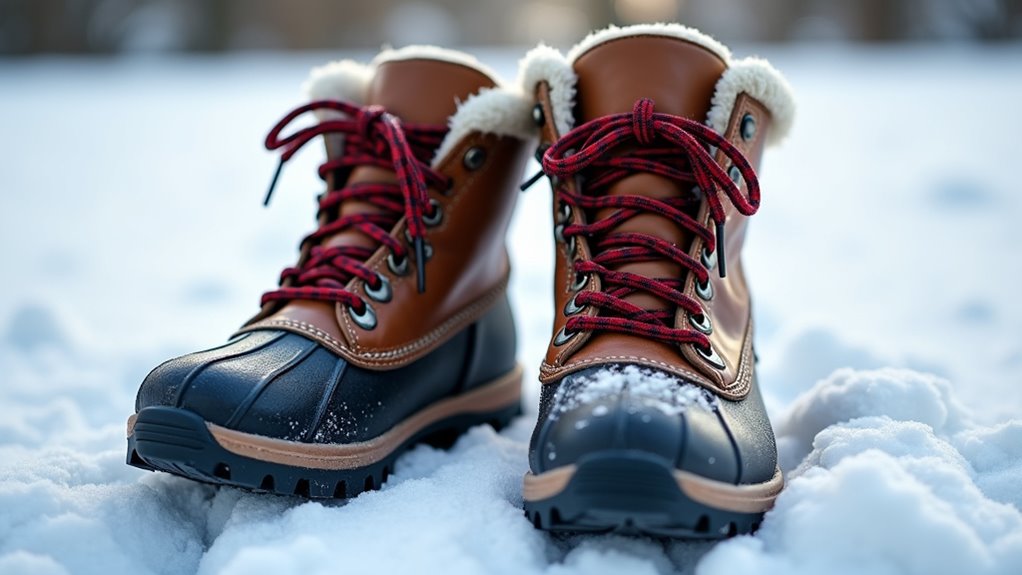
Keeping your feet warm is just the beginning - discover why winter camping boots make the difference between adventure and disaster.
Like a house built on sand, your winter camping adventure will crumble without the right boots to support it. You’ll quickly discover that your standard hiking boots won’t cut it when temperatures plummet and snow starts falling. While you don’t need to spend a fortune, you can’t afford to skimp on this essential piece of gear. Let’s explore how to choose winter boots that’ll keep you safe and comfortable without breaking the bank.
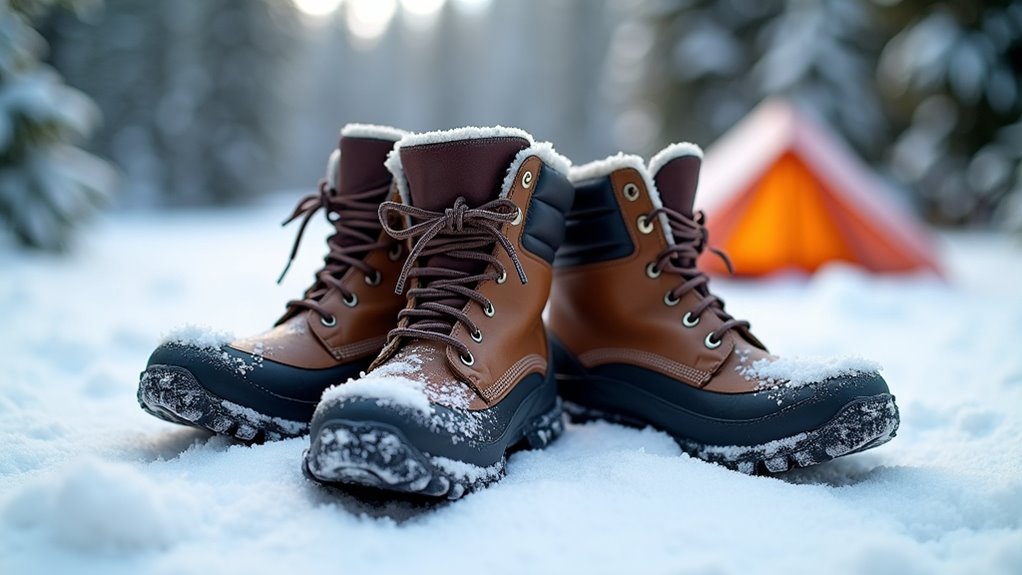
The success of winter camping hinges on your choice of boot materials, which directly impact warmth, comfort, and safety in freezing conditions.
You’ll find traditional insulation materials like felt, sheepskin, and wool provide reliable warmth, even when damp. While these natural fibers are bulkier, they’re often more affordable than synthetic alternatives. Cozy winter sleeping bags can also provide an extra layer of warmth when paired with the right boots.
For outer materials, you can’t go wrong with leather’s durability and water resistance, though heavy-duty nylon offers a lighter alternative. Popular models like the Sorel Caribou boot incorporate 9mm felt insulation with a cozy interior design.
Look for boots with waterproof membranes like Gore-Tex or similar technologies, as they’ll keep your feet dry while allowing sweat to escape.
When selecting insulation weight, consider that 200g to 400g is standard – higher weights mean more warmth but less mobility.
For maximum value, choose boots with removable liners, as they’re easier to dry and extend your boot’s usability across different conditions.
Winter boot temperature ratings can puzzle even seasoned campers, as they don’t always reflect real-world performance.
You’ll need to take into account that these ratings assume you’re consistently moving to generate body heat, and actual warmth varies based on your activity level and personal cold tolerance. Composite toe boots are a better choice than steel toe options for winter camping since they don’t conduct cold.
To make sense of temperature ratings, focus on these key points:
Winter Camping Boots are Essential for your adventures.
Remember to match your boot’s insulation to your planned activity level and take into account features like sole thickness and boot height when comparing options.
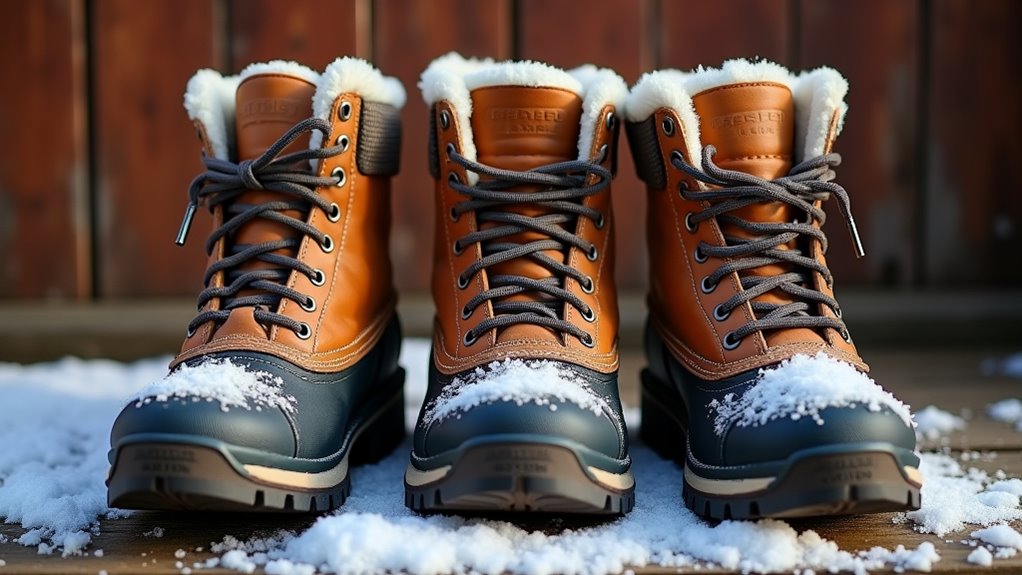
Understanding temperature ratings leads naturally to exploring insulation types, which form the core of a boot’s cold-weather performance. You’ll find Thinsulate and Primaloft are the most reliable synthetic options, offering excellent warmth without excessive bulk.
For winter camping, where you’re often stationary, look for boots with 400g to 600g of insulation to maintain warmth during inactive periods. Advanced materials like Aerogel from silica provide exceptional insulation through microscopic air pockets. Essential strategies for cold-weather camping survival can also help you stay warm in these conditions.
While synthetic materials dominate the market, don’t overlook wool or down insulation if your budget allows. They provide exceptional warmth, though you’ll need to guarantee proper waterproofing to maintain their effectiveness.
Whatever insulation you choose, make certain it’s paired with adequate waterproofing and breathability features. A well-insulated boot won’t perform if moisture seeps in or if sweat can’t escape during active periods.
Since your feet’s comfort and safety depend heavily on staying dry, selecting boots with proper waterproofing features should be your top priority.
When shopping for winter camping boots, you’ll find three main levels of moisture protection, with true waterproof boots offering the highest defense against wet conditions. While they’re more expensive, they’re worth the investment for serious winter camping. Cold temperatures necessitate warm, well-insulated boots to protect your feet from harsh winter elements. Essential gear for a cozy winter camping adventure includes properly waterproofed boots.
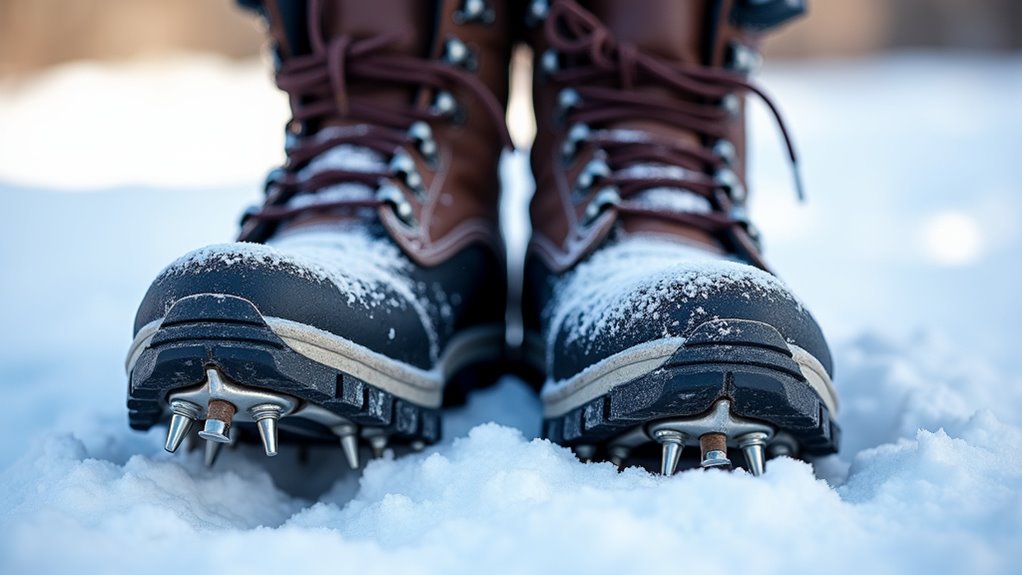
Maneuvering snowy and icy terrain safely requires dependable traction systems that complement your winter boots.
The Kahtoola MICROspikes are widely recognized as the best winter traction devices available today.
You’ll find microspikes with metal teeth are your best bet for packed snow and ice up to 5 inches deep, while chain-style devices with TIG welded links offer excellent grip for various winter activities. Camping mats can also provide additional insulation and comfort when used in conjunction with winter boots and traction devices.
For everyday winter walking, you can opt for cleats or ice grippers, though they won’t match the bite of spike-style systems.
Look for devices with hardened steel components and rubber uppers that’ll stay flexible in freezing temperatures. You’ll want a snug fit that won’t slip off your boots.
Don’t forget to inspect your traction system regularly for wear and tear.
A well-maintained device will keep you stable and confident while reducing the physical effort needed to navigate slippery conditions.
A proper winter boot fit makes the difference between enjoying your outdoor adventures and enduring miserable, cold feet.
When selecting your winter boots, you should consider sizing up from your regular shoe size to accommodate thicker socks and insulation while maintaining enough room for toe movement. EVA midsoles provide essential cushioning and shock absorption for winter hiking comfort. Proper insulation is crucial for keeping your feet warm in cold weather.
For the perfect winter boot fit, focus on these key elements:
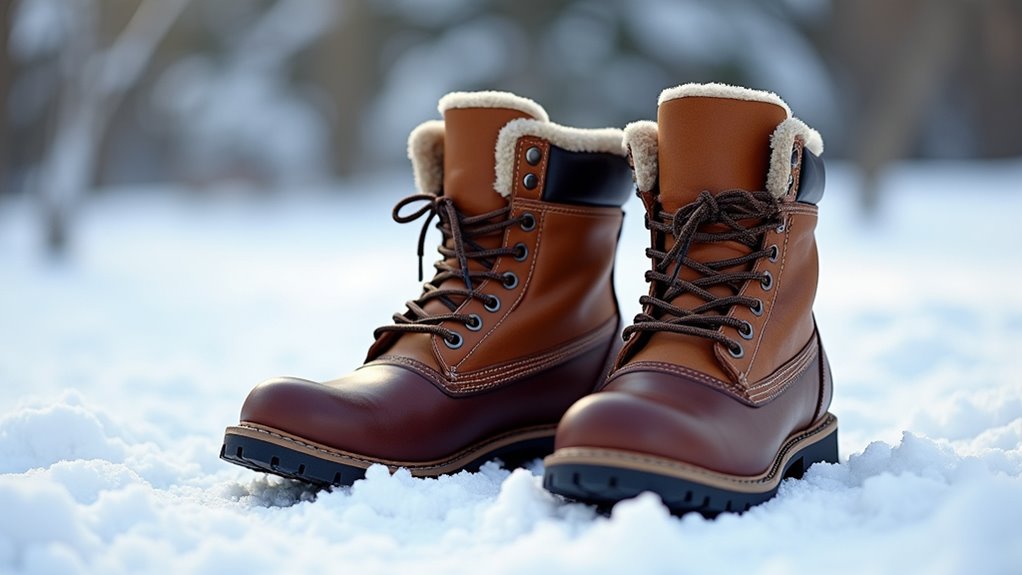
Proper ankle support represents a crucial yet often misunderstood aspect of winter camping safety. While high-top boots can reduce ankle inversion, they’re not a complete solution for injury prevention.
High-top boots alone won’t guarantee ankle safety during winter camping – proper support requires a comprehensive approach to injury prevention.
Research shows that pack weight and fatigue significantly influence ankle injury risk during winter hiking. Plus, choosing the right winter camping boots is essential for maintaining stability and preventing injuries.
You’ll need to balance support with muscle development, as over-reliance on rigid boots can actually weaken your ankles over time.
Choose boots based on your experience level and intended use. If you’re new to winter camping, you might benefit from more supportive boots while developing ankle strength.
However, if you’re experienced, consider lighter boots that allow natural movement and better ground feedback.
Remember that environmental factors matter too – your boots should match the terrain and conditions you’ll encounter.
Look for waterproof options with good traction for slippery conditions, but don’t sacrifice mobility and comfort for excessive support.
While ankle support protects your feet from injury, moisture management plays an equally essential role in winter camping comfort and safety. Your feet will sweat during activities, and without proper breathability, you’ll risk blisters, frostbite, and discomfort. Quality boots like the Gore-Tex membrane keep feet both warm and dry during extended winter hikes.
Understanding how to manage moisture in your winter boots can save you from costly mistakes and potential health risks.
Here’s what you need to know about boot breathability:
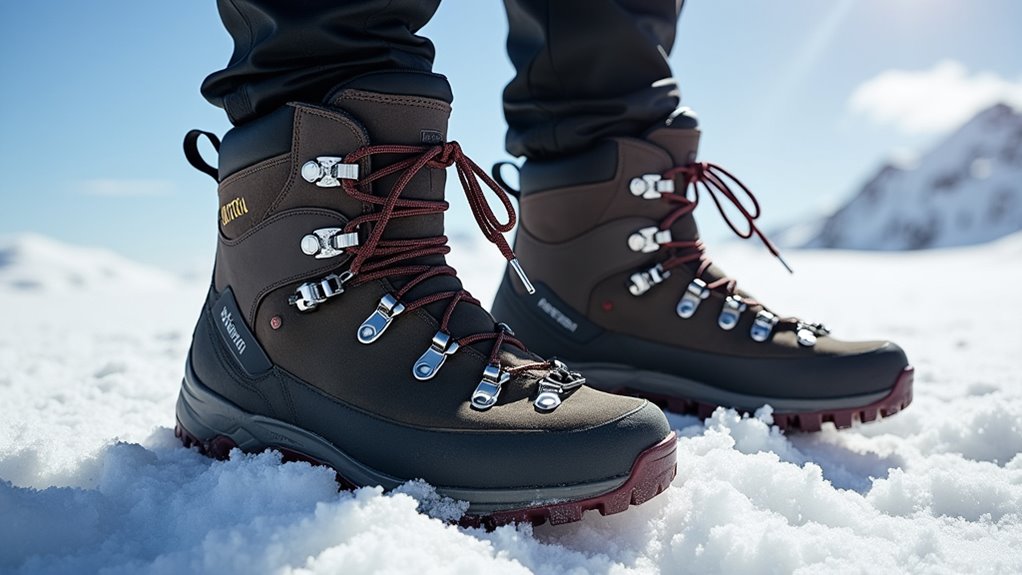
Selecting the right combination of winter boots and crampons can make or break your mountaineering experience.
You’ll need to match your boot type (B1, B2, or B3) with compatible crampons (C1, C2, or C3) for ideal safety and performance.
If you’re planning moderate snow hiking, B1 boots with C1 strap-on crampons will suffice.
For more technical terrain, you’ll want B2 boots with C2 crampons, which offer a secure heel lever system.
Technical mountaineering demands B3 boots with C3 crampons, featuring both toe and heel welts for maximum stability.
Using stainless-steel crampons will provide excellent durability while resisting rust in wet conditions.
Don’t compromise by mixing incompatible boots and crampons – it’s dangerous and could lead to equipment failure.
Confirm your boots have adequate sole rigidity and proper edge definition for effective crampon attachment and snow shedding. Essential sleeping bags can be crucial for ensuring a comfortable and safe outdoor experience.
Understanding boot weight becomes essential when you’re planning extended winter hikes, as every ounce matters over long distances.
While heavier boots like the Salomon Quest 4 GTX (23.4 oz) offer robust protection, they can drain your energy faster on lengthy trails. The North Face VECTIV Fastpack, weighing in at 17.0 ounces, demonstrates the ideal balance between protection and lightweight design. Consider the trade-off between weight and necessary features for your specific needs.
Essential tips for choosing camping clothes can provide additional guidance on selecting the right attire for your winter camping adventures.
When selecting winter boots, focus on these key weight-related factors:
You’ll find the sweet spot around the average weight of 17.9 oz, which offers sufficient protection without compromising mobility.
Your winter camping boots can make or break your outdoor experience. Consider the case of experienced hiker Sarah Chen, who learned this firsthand when her budget boots failed during a Mount Baker expedition. Don’t skimp on quality – but you’ll find excellent value in mid-range options like Salomon’s X Ultra Winter CS. Focus on waterproofing, insulation, and proper fit first, then add features as your budget allows.